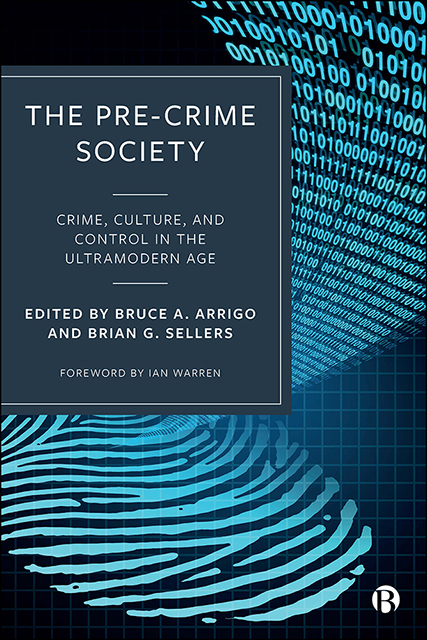Book contents
- Frontmatter
- Dedication
- Contents
- Notes on Contributors
- Foreword
- Introduction: The Ultramodern Age of Criminology, Control Societies and ‘Dividual’ Justice Policy
- Part I Theories, Theorists and Theoretical Perspectives
- Part II Institutions, Organizations and the Surveillance Industrial Complex
- Part III Dataveillance, Governance and Policing Control Societies
- Part IV Systems of Surveillance, Discipline and the New Penology
- Part V Globalizing Surveillance, Human Rights and (In)Security
- Afterword: ‘Pre-Crime’ Technologies and the Myth of Race Neutrality
- Index
4 - The Negation of Innocence: Terrorism and the State of Exception
Published online by Cambridge University Press: 14 April 2023
- Frontmatter
- Dedication
- Contents
- Notes on Contributors
- Foreword
- Introduction: The Ultramodern Age of Criminology, Control Societies and ‘Dividual’ Justice Policy
- Part I Theories, Theorists and Theoretical Perspectives
- Part II Institutions, Organizations and the Surveillance Industrial Complex
- Part III Dataveillance, Governance and Policing Control Societies
- Part IV Systems of Surveillance, Discipline and the New Penology
- Part V Globalizing Surveillance, Human Rights and (In)Security
- Afterword: ‘Pre-Crime’ Technologies and the Myth of Race Neutrality
- Index
Summary
Introduction
In her text, Regarding the Pain of Others, Susan Sontag (2003) explores the phenomenology evoked by the images of the victims of war. She (2003) observes that ‘photographs of the victims of war are themselves a species of rhetoric. They reiterate. They simplify. They agitate. They create the illusion of consensus’ (p. 6). This ‘illusion of consensus’, to which Sontag eludes, is predicated upon the belief that once these images detailing the destructive capacity of war are viewed, the concluding consensus will be that such atrocities must not be allowed to continue.
In rejecting such a conclusion, she offers a simple question: ‘But is it true that these photographs, documenting the slaughter of noncombatants rather than the clash of armies, could only stimulate the repudiation of war? Surely they could foster greater militancy on behalf of the Republic. Isn't this what they are meant to do?’ (Sontag, 2003, p. 8). Sontag (2003) concludes by observing that such images can only stimulate a repudiation of war, when politics is either dismissed or ignored from this phenomenological process. As such, images of war are rarely viewed as apolitical representations of ‘anonymous generic victims’ (p. 9); rather, they are often employed with the purpose of validating a specific point of view relative to the political narrative these images seek to evoke. ‘To those who are sure that right is on one side, oppression and injustice on the other, and that the fighting must go on, what matters is precisely who is killed by whom’ (Sontag, 2003, p. 10).
For Sontag, images of war become meaningful from the perspective of the viewer. She argues that the image of a Jewish child killed by a Palestinian suicide bomber or a Palestinian child torn apart by Israeli military ordinance in Gaza is rarely viewed as the murder of an anonymous victim. The very fact of these deaths comes to reinforce certain socially constructed beliefs concerning those responsible for these acts. From this perspective, these deaths can never be viewed as the murder of anonymous victims, for the simple reason that to do so would also require a reconfiguration of those socially constructed truths, which give these images their specific meaning (Verdery, 1999; Polizzi, 2019).
Who is killing whom in the digital age?
In the digital age, Sontag's construction of the ‘Who is Killing Whom’ dynamic, takes on a much more powerful relevance.
- Type
- Chapter
- Information
- The Pre-Crime SocietyCrime, Culture and Control in the Ultramodern Age, pp. 81 - 102Publisher: Bristol University PressPrint publication year: 2021

